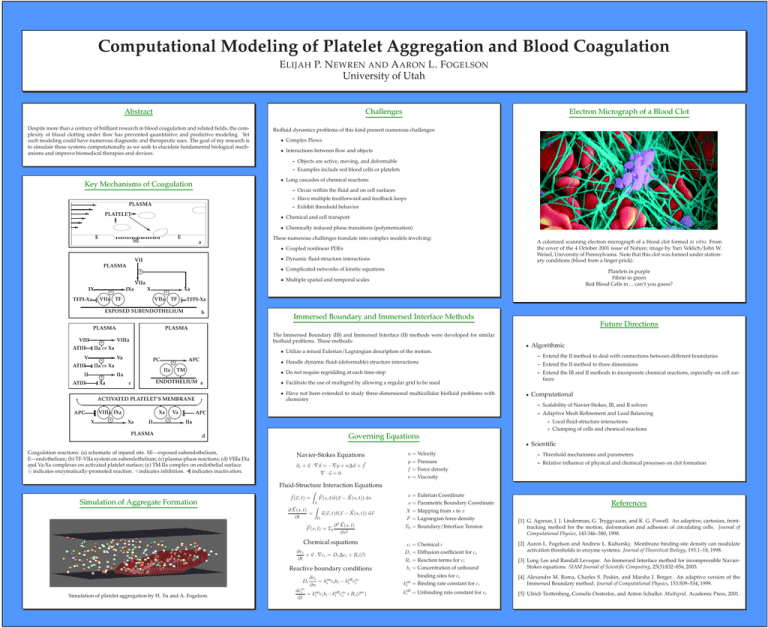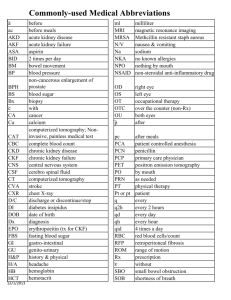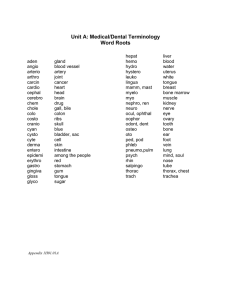Computational Modeling of Platelet Aggregation and Blood Coagulation E P. N A
advertisement

Computational Modeling of Platelet Aggregation and Blood Coagulation E LIJAH P. N EWREN AND A ARON L. F OGELSON University of Utah Abstract Challenges Despite more than a century of brilliant research in blood coagulation and related fields, the complexity of blood clotting under flow has prevented quantitative and predictive modeling. Yet such modeling could have numerous diagnostic and therapeutic uses. The goal of my research is to simulate these systems computationally as we seek to elucidate fundamental biological mechanisms and improve biomedical therapies and devices. Electron Micrograph of a Blood Clot Biofluid dynamics problems of this kind present numerous challenges: • Complex Flows • Interactions between flow and objects – Objects are active, moving, and deformable – Examples include red blood cells or platelets • Long cascades of chemical reactions Key Mechanisms of Coagulation - – Occur within the fluid and on cell surfaces – Have multiple feedforward and feedback loops PLASMA – Exhibit threshold behavior PLATELETQ ? Q Q Q s E • Chemical and cell transport • Chemically induced phase transitions (polymerization) E SE These numerous challenges translate into complex models involving: a A colorized scanning electron micrograph of a blood clot formed in vitro. From the cover of the 4 October 2001 issue of Nature; image by Yuri Veklich/John W. Weisel, University of Pennsylvania. Note that this clot was formed under stationary conditions (blood from a finger prick). • Coupled nonlinear PDEs • Dynamic fluid-structure interactions VII PLASMA • Complicated networks of kinetic equations +h ? VIIa - IXa - Xa X IX +h +h VIIa TF TFPI-Xa VIIa TF TFPI-Xa EXPOSED SUBENDOTHELIUM b PLASMA VIII ATIII V ATIII II ATIII Immersed Boundary and Immersed Interface Methods Future Directions PLASMA The Immersed Boundary (IB) and Immersed Interface (II) methods were developed for similar biofluid problems. These methods: - VIIIa +h IIa or Xa - Va +h IIa or Xa - IIa +h Xa Platelets in purple Fibrin in green Red Blood Cells in ... can’t you guess? • Multiple spatial and temporal scales • Utilize a mixed Eulerian/Lagrangian description of the motion. - APC PC +h c ACTIVATED PLATELET’S MEMBRANE VIIIa IXa Xa Va APC APC +h +h - Xa - IIa X II – Extend the II method to three dimensions • Do not require regridding at each time-step – Extend the IB and II methods to incorporate chemical reactions, especially on cell surfaces • Facilitate the use of multigrid by allowing a regular grid to be used • Have not been extended to study three-dimensional multicellular biofluid problems with chemistry • Computational – Scalability of Navier-Stokes, IB, and II solvers – Adaptive Mesh Refinement and Load Balancing ∗ Local fluid-structure interactions ∗ Clumping of cells and chemical reactions Governing Equations d • Coagulation reactions: (a) schematic of injured site. SE—exposed subendothelium, E—endothelium; (b) TF-VIIa system on subendothelium; (c) plasma-phase reactions; (d) VIIIa:IXa and Va:Xa complexes on activated platelet surface; (e) TM:IIa complex on endothelial surface. → ⊕ indicates enzymatically-promoted reaction. a indicates inhibition. indicates inactivation. Algorithmic – Extend the II method to deal with connections between different boundaries • Handle dynamic fluid-(deformable) structure interactions IIa TM ENDOTHELIUM e PLASMA • Navier-Stokes Equations ~ut + ~u · ∇~u = −∇p + ν∆~u + f~ ∇ · ~u = 0 Scientific u = Velocity – Threshold mechanisms and parameters p = Pressure f = Force density – Relative influence of physical and chemical processes on clot formation ν = Viscosity Fluid-Structure Interaction Equations Simulation of Aggregate Formation f~(~x, t) = Z ~ ∂ X(s, t) = ∂t S ~ F~ (s, t)δ(~x − X(s, t)) ds Z Ω ~ ~u(~x, t)δ(~x − X(s, t)) d~x ~ t) ∂ 2 X(s, F~ (s, t) = T0 ∂s2 Chemical equations ∂ci + ~u · ∇ci = Di ∆ci + Ri (~c) ∂t Reactive boundary conditions Di Simulation of platelet aggregation by H. Yu and A. Fogelson. ∂ci = kion ci bi − kioff cm i ∂n dcm i cm ) = kion ci bi −kioff cm i +Ri (~ dt x = Eulerian Coordinate s = Parametric Boundary Coordinate X = Mapping from s to x F = Lagrangian force density References T0 = Boundary/Interface Tension [1] G. Agresar, J. J. Linderman, G. Tryggvason, and K. G. Powell. An adaptive, cartesian, fronttracking method for the motion, deformation and adhesion of circulating cells. Journal of Computational Physics, 143:346–380, 1998. ci = Chemical i Di = Diffusion coefficient for ci [2] Aaron L. Fogelson and Andrew L. Kuharsky. Membrane binding-site density can modulate activation thresholds in enzyme systems. Journal of Theoretical Biology, 193:1–18, 1998. Ri = Reaction terms for ci bi = Concentration of unbound [3] Long Lee and Randall Leveque. An Immersed Interface method for incompressible NavierStokes equations. SIAM Journal of Scientific Computing, 25(3):832–856, 2003. binding sites for ci kion = Binding rate constant for ci [4] Alexandre M. Roma, Charles S. Peskin, and Marsha J. Berger. An adaptive version of the Immersed Boundary method. Journal of Computational Physics, 153:509–534, 1999. kioff = Unbinding rate constant for ci [5] Ulrich Trottenberg, Cornelis Oosterlee, and Anton Schuller. Multigrid. Academic Press, 2001.





